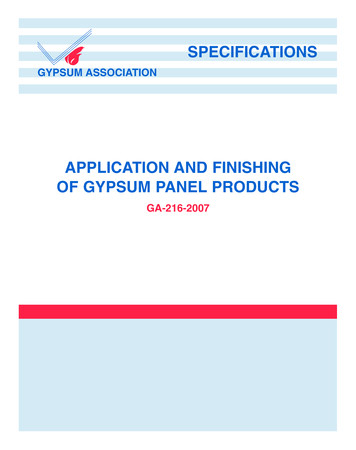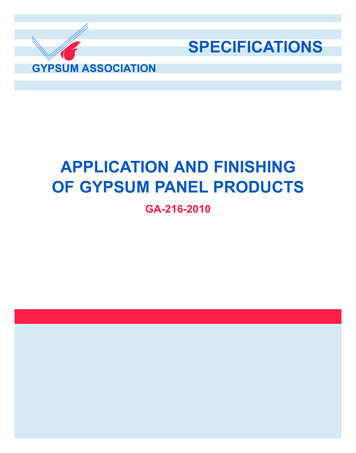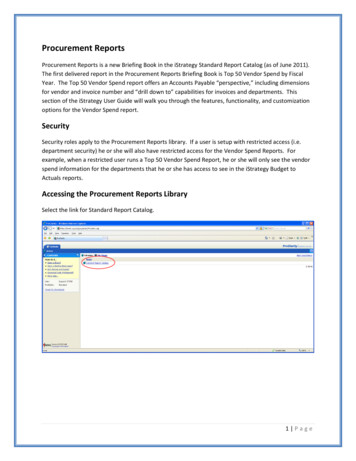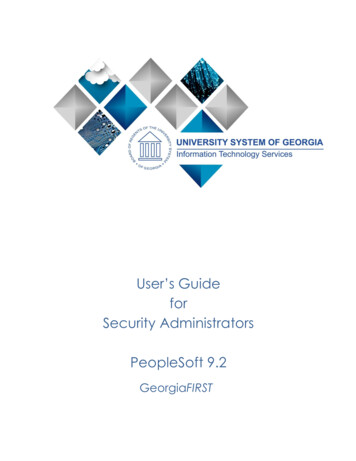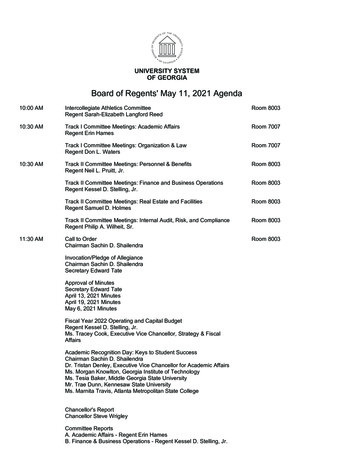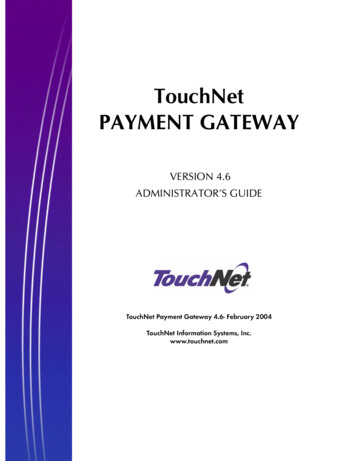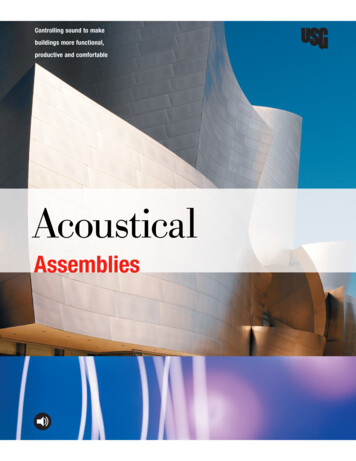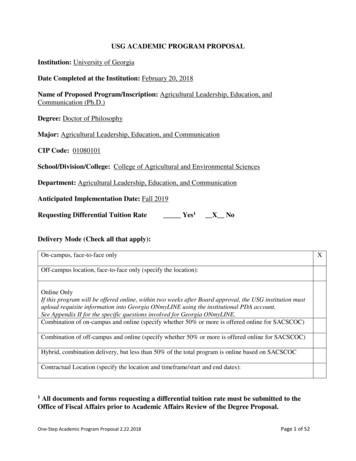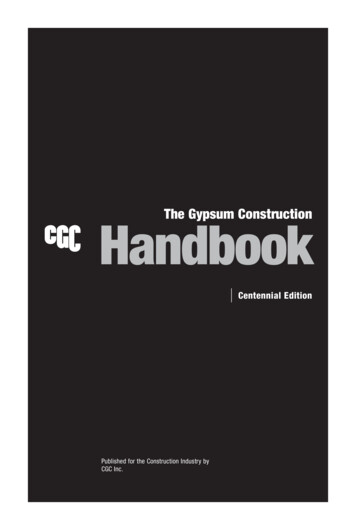
Transcription
The Gypsum ConstructionHandbookCentennial EditionPublished for the Construction Industry byCGC Inc.
iiImportant Notes to This EditionThis edition of the Gypsum Construction Handbook is a guide toconstruction procedures for gypsum drywall, cement board, veneerplaster and conventional plaster construction in effect in 2004.Information, standards, products, product names, properties, application methods, procedures, etc., contained herein are subject to change.For the latest available information concerning CGC products, systemsor recommended application procedures, contact your local CGC salesoffice or representative toll-free at 888-206-1110 (Atlantic);800-361-1310 (Quebec); 800-387-2690 (Ontario); 800-663-1055(Western); or see the CGC website (http://www.cgcinc.com).All information, details, specifications, data, applications, procedures,etc., contained in this handbook are intended as a general guide whenusing CGC-manufactured or supplied products. CGC assumes noliability for failure resulting from the use of this handbook or for failurefrom improper application or installation of its products.CGC products must not be used in the design or construction of anystructure without a complete and detailed evaluation by qualified engineers, architects and/or acoustical consultants to verify the suitabilityof these products for use in any given structure. Competent supervision of component installation is recommended to achieve desiredresults.Information from this publication should be used only in conjunctionwith CGC-manufactured products or products supplied by CGC, asphysical properties among competitive products may vary.Information about CGC products that contain recycled materials, aswell as a discussion on environmental acceptability of CGC productsand what steps CGC is taking to protect the environment in the futuremay be found on page vii.
Gypsum Construction Handbook Centennial EditionTrademarksiiiCGC Inc. owns or is a licensed user of the following trademarks usedherein: ACOUSTONE; ACOUSTIBOND; ACRYGLO; AIRTROL; AP LITE; AQUA-TOUGH,AURATONE; AX; BEN FRANKLIN; BILLO; BRIDJOINT; CADRE; CELEBRATION;CENTRICITEE; CHAMPION; CLEAN ROOM; CLIMAPLUS; COMPÄSSO; COVER COAT;CURVATURA; DIAMOND; DIAMONDFLEX; DONN; DURACAL; DUR-A-BEAD;DURABOND; DUROCK; DUROSCREEN; DX; DXL; DXLA; DXW; EASY SAND;ECLIPSE; “F” FISSURED; FACTS-ON-DEMAND; FIBEROCK; FIRECODE; FROST;GEOMETRIX; GLACIER; GRIDWARE; GYP-LAP; HIGHLINE; HYDROCAL; IMPACTION;IMPERIAL; INSULSCREEN; LEVELROCK; LIGHTFRAME; LINEA; MARS; MERIDIAN;METAL FACE; MILLENNIA; ORIENTAL; ORION; PANZ; PARALINE; PARALOCK; PLUS 3;PREMIER HI-LITE; PREMIER NUBBY; QUADRA; QUADRADOME; QUIK & EASY;QUICK-RELEASE; RC-1; RADAR; RED TOP; RENDITIONS; RIGID-X; ROCK FACE;ROCKLATH; ROTUNDA; SANDRIFT; SHEETROCK; SILENT BAFFLES; SILENTEXPRESSIONS; SILENT SQUARES; SKYFRAME; SKYLITE; SMOKE SEAL; SNOW WHITE;SPEED BEAD; STAR; STRUCTO-BASE; STRUCTOCORE; STRUCTO-GAUGE;STRUCTO-LITE; SUMMIT; TEXOLITE; TOPO; TRANSPARENCIES; TUF TEX; ULTRACODE;ULTRASCREEN; ULTRAWALL; CGC; CGC ACTION; WIREWORKS, ZXA; and ZXLA.BONDCRETE; GRAND PRIZE; IVORY; MORTASEAL; and SNOWDRIFT are trademarksof GenLime Group L.P. THERMAFIBER is a trademark of Thermafiber LLC.BUILDEX, CLIMASEAL; CONDRIVE; TAPCON; TYPE S; and TYPE S-12 are trademarks of ITW Buildex. TYVEK and HOMEWRAP are trademarks of DuPont.MASTERSPEC is a trademark of American Institute of Architects.MASTERFORMAT is a trademark of Construction Specifications Instituteand Construction Specifications Canada. SWEET’S is a trademark ofMcGraw-Hill Sweet’s Group. COLORTREND and AMBIANCE are trademarksof Creanova, Inc.EditorialCommitteeThe Editorial Committee for this edition of CGC Gypsum ConstructionHandbook was headed by Bob Mercer and included Jeff Glancie, TrevorMcGregor, Larry Dean and Yannick Devost. Carole Caron was the printproduction co-ordinator.Published by CGC Inc.Copyright 2005, CGC Inc.Printed in Canada.ISBN:1-896010-10-5
ivA Century of BuildingThis “Centennial Edition” of the Gypsum Construction Handbookrecognizes not only the dawning of a new century, but also the factthat CGC is about to celebrate its 100th anniversary in supplyingbuilding materials to build Canada and the world. We intend that thisnew edition will be a valued companion for you for many years intothe twenty-first century.Since its earliest version in 1905, the CGC/United States GypsumCompany Gypsum Construction Handbook has been the best reference forgypsum products and systems in the building industry. Throughout theyears it has evolved and changed as the building industry itself has evolvedand changed. This edition has been reorganized to make it easier than everto use and to find the specific information you are looking for.– It has been printed in a larger size to make it easier to read and morepleasing to look at.– We’ve divided the “Finishing” chapter into separate chapters on drywallfinishing and veneer plaster finishing to help you find the specific information you are seeking.– We’ve added improved photos and illustrative details to make informationclearer for you.– We’ve provided more information on subjects that readers of our previouseditions have asked for, including entire chapters on acoustical ceilingsand safety.– We’ve added many new products and construction techniques concerning not only gypsum products, but cement board products as well.– The most popular feature of previous editions has been the comprehensive key word index; we’ve further expanded and improved it tomake it even more valuable.
Gypsum Construction Handbook Centennial EditionvFounded in 1902, United States Gypsum Company’s concentration onquality has ensured its success in the development of gypsum plastersand cements for the construction industry. Continued research andinnovation enabled the Corporation to revolutionize the industry in theearly 1930s with the introduction of ROCKLATH Gypsum Lath, a paperbound gypsum board that replaced conventional wood and metal lathas a base material for conventional plaster. Later in the same decade,advancements in production technology and research in gypsumbased compounds resulted in the development of larger gypsum panels.As the Corporation perfected systems to join the panels together, itintroduced the SHEETROCK Brand Drywall Systems that have become thestandard of the construction industry throughout the world.The innovations continue to this day. In this last twenty years alone, theCorporation has pioneered major advances in DUROCK Brand CementBoard construction, lightweight SHEETROCK Brand Joint Compounds,high performance sound-control assemblies, fire-rated systems, highstrength veneer plasters and drywall surface preparations. The mostrecent innovations have been in the area of abuse-resistant construction, where a variety of drywall and plaster products, including FIBEROCKBrand Abuse-Resistant Panels, have been developed.CGC Inc. was founded in 1907 as Canadian Gypsum Company byUnited States Gypsum Company. For nearly 100 years, it has been thename to be trusted for quality and fire/sound performance in theCanadian Construction industry. The Corporation’s spirit of innovationwill help us retain our reputation as construction moves into thetwenty-first century and CGC’s second century.Introduction and ContentsThe Purpose ofthe HandbookThis edition of the Gypsum Construction Handbook is a guide to goodconstruction procedures for gypsum drywall, veneer plaster, cementboard and conventional plaster construction. It contains the newestdevelopments in products and systems including time-saving, lower-costmethods of installation to simplify and speed construction.The book, which has become a standard handbook in the constructionindustry, serves as a valuable reference for those with broad experienceand those who wish to learn about gypsum construction.Architects, Designers and Engineers Technical information on gypsumproduct construction standards, including available system descriptions,fire- and sound-rated construction, limitations and installation procedures.Contractors, Builders and Dealers Full data on all aspects of gypsumproducts and accessories, tools and equipment, and applicationincluding information for estimating and planning.
viApprenticeship Training Schools Well organized, easy-to-understand, illustrated directions for applying gypsum products from framing to finish.Journeymen A comprehensive index to contents and clear, conciseillustrated directions and techniques for applying gypsum productsfrom framing to finish.Building Officials and Code Users Fire, sound and physical testdata; proper construction procedures for gypsum products to ensurecompliance with performance criteria.How to Use the HandbookTo find the information you want, use the table of contents or the fullycross-referenced index in the back to find the applicable reference ondrywall, veneer or conventional plaster, or cement board construction.The handbook is organized as follows:Drywall & Veneer Plaster ConstructionChapter 1ProductsChapter 2FramingChapter 3CladdingChapter 4Cement Board ConstructionChapter 5Finishing Drywall SystemsChapter 6Finishing Veneer Plaster SystemsConventional Lath & Plaster ConstructionChapter 7Conventional Plaster ProductsChapter 8Conventional Plaster ApplicationSuspended Acoustical Ceiling SystemsChapter 9Acoustical Ceiling Design & ApplicationGeneral ConstructionChapter 10 System Design ConsiderationsChapter 11 Planning, Execution & InspectionChapter 12 Problems, Remedies & Preventive MeasuresChapter 13 Safety Considerations, Material HandlingChapter 14 Tools & EquipmentAppendixGlossaryKey Word IndexAlphabetical Index to Tables
Gypsum Construction Handbook Centennial EditionviiEnvironmental ResponsibilityCGC Inc. works hard to be as friendly to the environment as possible.The following general statement provides an overview of CGC’s commitment to the environment. Specific information about percentage ofrecycled material in specific products or answers to other questionsmay be obtained by writing to Dept. 292, CGC Inc., 350 BurnhamthorpeRoad West, 5th Floor, Mississauga, Ontario, L5B 3J1.Assurance We recognize the importance of safeguarding the environment. We offer our customers products that are environmentallyacceptable, safe and effective when used as intended. We are committed to our employees, our customers and our communities andbelieve that health, safety and environmental well-being can andshould be compatible with economic health. We will continue to conduct our operations in compliance with applicable laws and regulations, continuously reviewing all procedures, practices and products.Dedication We are a leading manufacturer/supplier of drywall, plaster, cement board, joint treatment, ceiling tile and suspension systems,and commercial life-safety systems. With plants throughout NorthAmerica, USG and CGC remain dedicated to environmental issueswhile maintaining our high standard of product quality and service. Weuse recycled and sustainable raw materials in product formulation anddevelopment. Using recycled goods as raw material provides numerous environmental benefits such as reducing demands on municipallandfills, mitigating mining and logging operations, and preservingdepletable natural resources.Leadership CGC/USG has a long history of utilizing recycled materialsin manufacturing building products. We use synthetic gypsum, a byproduct of various industrial processes, to manufacture ceiling products andwallboard, in addition to natural gypsum. In 1993, USG (as a foundingmember) helped establish the U.S. Green Building Council, a coalition ofprincipal building industry groups whose mission is to promote energy,health, productivity and environmental improvement for “whole” buildings. USG is also involved in construction of recycling demonstration projects with the National Association of Home Builders (NAHB).CGC Inc. Metric PolicyCGC has manufactured metric sized products for many years on aspecial order basis. CGC will make every reasonable effort to makemetric products available to the market on a special order basis.CGC is prepared to offer metric sizes in most of its acoustical paneland suspension systems.Metric width and length SHEETROCK Brand Gypsum Panel products willbe available from designated manufacturing plants throughout Canada.Metric length and width DUROCK Brand Cement Board products will alsobe available from designated manufacturing plants. Certain minimumorder quantities and up-charges may apply, as determined by localmarket conditions.
viiiBag and pail products, including CGC Brand Joint Treatment Products,spray textures, gypsum plasters and other products carry soft metricdesignations for size and/or weight.Important: The basic CGC product line remains unchanged. Standardfoot/inch/pound products previously available from CGC will still bereadily available. The addition of metric length/width products will allowus to supply all job requirements, whether imperial or metric.CGC will offer assistance to construction professionals with regard todesign, specification and installation issues involving our metric products,just as we always have with our standard products.In metric construction, many building materials, systems and documents are affected.Dimensions Units have changed from feet and inches to millimeters,scales from inch fractions to feet (for example, 1/4 1 0 ) to trueratios (such as 1:20). Drawings are not to be dual dimensioned, inorder to avoid dimensional conflicts and errors.Specifications Specs call for metric linear dimensions, areas, andvolumes.Construction Products A majority of construction products do notchange in size since they are not modular or panelized. They are simply “soft converted” or re-labeled in metric dimensions.Framing Stud spacing has changed from 16 to 400 mm and 24 to600 mm. Wood studs are now known as their actual size 38 x 89 mm(2 x 4 nom).Batt Insulation Width has changed from 16 and 24 nominal to 400 mmand 600 mm nominal.Ceiling Systems Grids and lay-in ceiling tile, air diffusers and lighting fixtures, from 2 x 2 to 600 mm x 600 mm and from 2 x 4 to600 mm x 1200 mm. Grid profiles, tile thicknesses, air diffusercapacities and fluorescent tubes have not changed.For more information and assistance on metric projects, see the current CGC literature on product sizing and availability. Information onspecific metric product availability in your market area may be obtainedfrom CGC sales or customer service representatives. They can bereached at your local sales office. See inside the back cover of thisbook for information on reaching your nearest CGC sales office. Also,there is more information on metric terms and a table of metric equivalents on pages 438-439 of the Appendix.
Gypsum Construction Handbook Centennial EditionixCGC Products and SystemsCGC offers a wide variety of quality products and performance-engineered systems. These systems are designed to consider all major factors: cost, sound control, fire resistance, structural capacity, estheticsand overall utility and function.Thin, lightweight gypsum panel drywall and cement board assembliesare noted for their fast installation and low cost. They are used in themajority of new residential buildings and have gained similar acceptance in commercial buildings.This handbook contains the latest information about proper gypsumdrywall, plaster and cement board construction available at the time ofits writing. The text covers framing installation, drywall and veneerplaster construction, joint treatment and plaster finishing, interiorcement board construction, and conventional plaster application, aswell as the tools required for each job. It also covers special engineeredsystems, product application factors, problems and remedies, and various repair and remodeling techniques.The Manufacture ofGypsum ProductsThe development of all gypsum products begins with a mined mineralrock, gray to white in color, called gypsum. The basic mineral is composedof calcium sulfate chemically combined with water of crystallization —CaSO4 2H2O. The combined water makes up approximately 20% ofthe weight of gypsum rock. This is the feature that gives gypsum itsfire-resistive qualities and makes it so adaptable for construction purposes.After gypsum rock is mined or quarried, it is crushed, dried, and groundto flour fineness, then calcined to drive off the greater part of thechemically combined water as steam. This calcined gypsum, commonly called plaster of paris, is then mixed with water and other ingredients and sandwiched between two sheets of specially manufacturedpaper to form various types of gypsum board or specially formulatedand bagged for shipment as gypsum plaster or cement.While mined gypsum has been the traditional raw material for drywalland plaster products, more and more “synthetic” gypsum is used in themanufacturing process. Synthetic gypsum is a material that is abyproduct of an industrial process. For example, in most power plants,the burning of coal produces undesirable emissions of sulfur, a leadingcause of acid rain. A wet lime-limestone scrubber is a common methodfor removing this pollution from the air. It works via a device installedon the exhaust (smoke stack) of the coal-burning furnace; as theexhaust smoke rises through the scrubber, the pollutants are chemically removed. The calcium and water in the wet limestone combinewith the sulfate in the exhaust to create calcium sulfate (gypsum) andwater. This material is called either “synthetic” or “chemical” gypsumand can be readily used to manufacture gypsum products.Gypsum manufacturers are increasingly using this material as a substitute for mined gypsum. The U. S. Bureau of Mines estimates that
xroughly 20 million tonnes of synthetic gypsum were generated in 1993by electric utilities equipped with wet lime-limestone scrubbers. CGCand other gypsum manufactures have worked with utilities on sourcingsynthetic gypsum for wallboard production.Gypsum boards are formed in a highly automated continuous process.After the gypsum core has set, the boards are cut to length, dried, prefinished if required, and packaged for shipment. All processing is instrict accordance with specifications to meet quality standards.Cement board products have some of the same characteristics as gypsum boards, but without the disadvantage of being sensitive to water.Cement boards are manufactured from strong, water-durable portlandcement, formed in a continuous process of aggregated portlandcement slurry with polymer-coated, glass-fiber mesh completelyencompassing edges, back and front surfaces, in a patented process.The ends are square cut. The most-popular use for cement board is asa substrate for ceramic tile on walls and floors, because of its durability. A wide variety of sizes are available for floors, walls, ceilings, countertops and as a wall shield for solid-fuel room heaters and fireplacestoves.The continued advancement of gypsum construction depends onmaintaining quality while reducing construction time and costs. CGChas consistently been at the forefront of this effort. New products forbroader uses and new cost-saving systems with improved fire andsound resistance are continually being developed and tested at theUSG Research Center. Once quality is ensured, strategically locatedoperating plants produce and/or stock the building materials describedhere.Advantages ofGypsum ProductConstructionLife Safety Protection Fire resistance is inherent in gypsum or cementboard construction. Systems provide permanent fire resistance notsubject to loss of water pressure or other malfunctions and problemsthat may occur in sprinkler systems.Fire Resistance Neither gypsum nor portland cement panels will support combustion. When attacked by fire, the chemically combinedwater in the gypsum crystal is released and turns to steam to helpretard the spread of flame and protect adjacent c
twenty-first century and CGC’s second century. Introduction and Contents The Purpose of This edition of the Gypsum Construction Handbookis a guide to good the Handbook construction procedures for gypsum drywall, veneer plaster,
